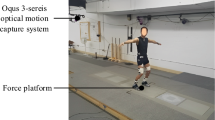Abstract
During walking, muscles must perform positive work to replace the energy lost from the body at each step, even if the average speed is constant and the terrain level. Young children have immature and irregular walk, but little is known about the effect of this walking pattern on the muscular external work done. Our objective was to measure using force platforms and the method of Cavagna (J Appl Physiol 39:174–179, 1975) the amount of muscular external work done by 1-year-old-, 4-year-old children and adults during walking. We were interested to quantify the approximation made by measuring only the positive external work done and assuming it reflects the external work done. After having confirmed that young children were not able to walk at a constant average speed over a complete number of steps, we showed the effect of the selection of trials by measuring the external work done assuming the amount of positive work done is equal to the negative work done (supposing there is no acceleration or deceleration over a complete number of steps). We observed that even if young subjects were not able to walk at a constant lateral speed over a complete number of steps, the amount of work done to maintain the center of mass movements in the transversal plane is not more than 10% of the external positive work done. This observational study points out that the measurement of external work, a good summary indicator for the gait mechanics, may be interpreted precociously when the population studied walked irregularly.

Similar content being viewed by others
References
Bastien GJ, Heglund NC, Schepens B (2003) The double contact phase in walking children. J Exp Biol 206:2967–2978. doi:10.1242/jeb.00494
Caty GD, Detrembleur C, Bleyenheuft C, Deltombe T, Lejeune TM (2008) Effect of simultaneous botulinum toxin injections into several muscles on impairment, activity, participation, and quality of life among stroke patients presenting with a stiff knee gait. Stroke 39:2803–2808. doi:10.1161/STROKEAHA.108.516153
Cavagna GA (1975) Force platforms as ergometers. J Appl Physiol 39:174–179
Cavagna GA, Kaneko M (1977) Mechanical work and efficiency in level walking and running. J Physiol 268:467–481
Cavagna GA, Franzetti P, Fuchimoto T (1983) The mechanics of walking in children. J Physiol 343:323–339
Detrembleur C, Van den Hecke A, Dierick F (2000) Motion of the body centre of gravity as a summary indicator of the mechanics of human pathological gait. Gait Posture 12:243–250. doi:10.1016/S0966-6362(00)00081-3
Detrembleur C, Lejeune TM, Renders A, Van den bergh PYK (2002) Botulinum toxin and short-term electrical stimulation in the treatment of equinus in cerebral palsy. Mov Disord 17:162–169. doi:10.1002/mds.1282
Hallemans A, Aerts P, Otten B, De Deyn PP, De Clercq D (2004) Mechanical energy in toddler gait: a trade-off between economy and stability? J Exp Biol 207:2417–2431. doi:10.1242/jeb.01040
Ivanenko YP, Dominici N, Cappellini G, Dan B, Cheron G, Lacquaniti F (2004) Development of pendulum mechanism and kinematic coordination from the first unsupported steps in toddlers. J Exp Biol 207:3797–3810. Erratum in: J Exp Biol 20:4011. doi:10.1242/jeb.01214
Massaad F, Dierick F, van den Hecke A, Detrembleur C (2004) Influence of gait pattern on the body’s centre of mass displacement in children with cerebral palsy. Dev Med Child Neurol 46:674–680. doi:10.1017/S0012162204001136
Schepens B, Bastien GJ, Heglund NC, Willems PA (2004) Mechanical work and muscular efficiency in walking children. J Exp Biol 207:587–596. doi:10.1242/jeb.00793
Stoquart GG, Detrembleur C, Palumbo S, Deltombe T, Lejeune TM (2008) Effect of botulinum toxin injection in the rectus femoris on stiff-knee gait in people with stroke: a prospective observational study. Arch Phys Med Rehabil 89:56–61. doi:10.1016/j.apmr.2007.08.131
Tesio L, Lanzi D, Detrembleur C (1998) The 3-D motion of the centre of gravity of the human body during level walking. I. Normal subjects at low and intermediate walking speeds. Clin Biomech (Bristol, Avon) 13:77–82. doi:10.1016/S0268-0033(97)00080-6
Acknowledgments
We would like to thank Martin Goblet for assistance in the pre-analysis of these experiments.
Author information
Authors and Affiliations
Corresponding author
Rights and permissions
About this article
Cite this article
Schepens, B., Detrembleur, C. Calculation of the external work done during walking in very young children. Eur J Appl Physiol 107, 367–373 (2009). https://doi.org/10.1007/s00421-009-1132-4
Accepted:
Published:
Issue Date:
DOI: https://doi.org/10.1007/s00421-009-1132-4




